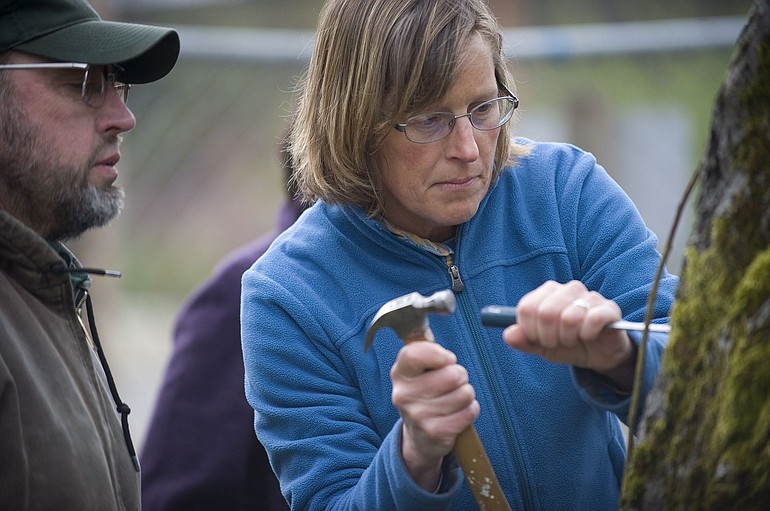With the “WHACK!” of hammer hitting chisel, Laurie Thompson set out to do some surgery on one of Vancouver’s most venerable inhabitants.
Thompson made a return visit Tuesday to help the city’s Old Apple Tree continue its recovery from recent setbacks. The National Park Service orchardist grafted several twigs onto the apple tree, including some expected to provide material for another grafting project in a year or so.
Thompson was working under a freckling of pink apple blossoms and pastel green leaves, indicating that the tree still has plenty of life in it — even though it’s around 185 years old.
The tree, which sprouted from an apple seed around 1825, is Vancouver’s only living survivor of the Hudson’s Bay Company era.
It was damaged in June 2009 when two of its three main limbs snapped, creating two gaping cavities in the trunk.
Thompson, who is based at a heritage apple orchard in Stehekin, near Lake Chelan, did her first work on Vancouver’s Old Apple Tree a year ago.
On Tuesday, Thompson grafted several small twigs onto the trunk for what will be the first phase of a two-stage process. She hopes those grafts will be nicely established in a year, and still be flexible.
Then Thompson will be able to graft the tops of those branches onto the trunk above the hollow, providing a better path for nutrients to the upper portion of the trunk.
A year ago, she tried a “bridge” technique, grafting both ends of twigs — below and above the cavity — to bypass the wound in the trunk. It didn’t work as well as the traditional grafts Thompson did last year; several of those slender twigs are budding nicely.
It’s possible to do some pretty creative repairs with grafts, Thompson said. You can direct a grafted branch into a hollow in the tree “and get a new trunk going,” she said.
The grafting procedures are part of the recovery project undertaken by a research team that includes city forester Charles Ray and local orchard operator Joe Beaudoin. The compacted dirt inside the tree’s enclosure was replaced in February 2010 by fertilized soil that is providing a big boost.
“It’s responding really well to the soil restoration,” Ray said. “You can see vigorous growth.”
The spongy surface underfoot was another indicator of a healthy environment, Ray said.
“This was a heavily compacted area, with people walking on it,” Ray said. A chain link fence installed to protect the tree also has prevented people from pounding the soil into something like a walking path.
Other recovery tactics included cutting limbs back to force more growth in the lower portions of the tree, and getting more sunlight to the tree. Several nearby laurels that literally overshadowed the apple tree were cut down.
“The tree had turned to get light, almost like a sunflower, and that’s where it broke,” Beaudoin said.
Tuesday’s graft material, called “scion” wood, was harvested in December when the tree was pruned. The shoots were refrigerated at the U.S. Department of Agriculture’s national plant germplasm repository in Corvallis, Ore., until the right time for grafting.
Tom Vogt: 360-735-4558 or tom. vogt@columbian.com.




